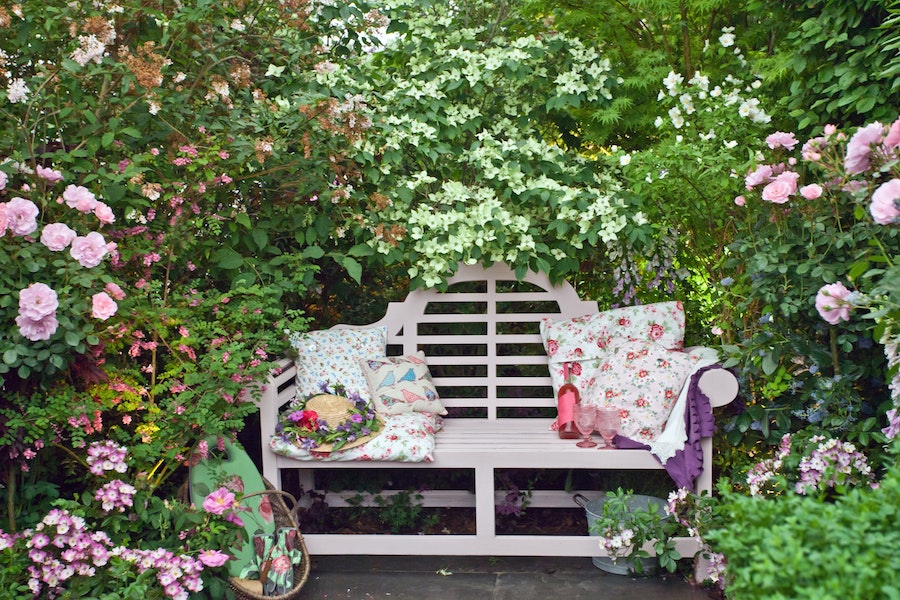Too hot to sit in the garden? 7 expert tips for creating a shady sanctuary
While the mercury continues to rise, a shady spot in your outdoor space provides a welcoming retreat, whether under a canopy of trees or a pergola adorned with climbers.
Even just a bench sheltered from the sun by colourful blooms, can provide a comfortable and pretty shaded stop.

Rosa ‘Phyllis Bide’ shades a bench
And while your summer bedding continues to bloom during the heatwave, lush, deep green foliage plants and other cooling specimens will be thriving in the shade.
Here, Mark Sage, head of horticulture at Wyevale Garden Centres, offers some top tips for planting in the shade…
1. Change your expectations

Shade-loving hostas provide a tropical feel to darker spots
Shade can come from buildings, trees, fences and dominant evergreen plants. Change your expectations of shady planting and think about foliage, form, texture, muted colours and bold drifts.
Many plants do well in shade, as the soil in shady areas can retain moisture and provide ideal growing conditions. One of the joys of planting in the shade is luscious foliage. Rich foliage can be enhanced by adding splashes of colour, with shade-tolerant Busy Lizzies, stocks, violas and nicotiana.
2. Manage dry shade
Dry shade can be a challenge, but it’s not an impossible growing condition for plants. The main problem is the lack of light and moisture.
Dry shade can often be found near trees, as their roots take moisture from the soil, as well as at the foot of walls or directly under roofs.

Trees can create dry shade
Good plants for under trees include Camellia japonica ‘Adolphe Audusson’, Viburnum davidii, Fuchsia magellanica var. molinae, Fritillaria meleagris and Iris foetidissima.
For plants to thrive in dry shade, add as much organic material to the area as possible, such as homemade leaf mould, compost or soil conditioner. This will help retain moisture and improve the soil condition. Organic material will also improve the soil structure and increase the amount of good bacteria and organisms in it. These break down plant material and help to build up the amount of nutrients naturally available in the soil.

Viburnum tinus can do well in dry shade
You’ll need to use a fork to work the organic material into the ground, and water the area afterwards. Some plants that require a continually moist soil won’t do well in dry shade, so it’s important – as with any problem area in the garden – that you do your research on the plant before planting.
Good plants for dry shade include Lamium maculatum ‘White Nancy’, Dryopteris affinis ‘Angustata Crispa’, Viburnum tinus, Sarcococca confusa, Asplenium scolopendrium ‘Angustatum’.
3. Use the right fertilisers
Using a fertiliser will help add nutrients directly to the soil in a form that plant roots can absorb quickly. Don’t use high nitrogen fertilisers, as you want to promote shade-tolerant plant growth and these fertilisers rely on sunlight. Instead, use sulphate of potash, which has a very high potassium content, or wood ash from a bonfire.
4. Find out the pH

Test your soil
Use a soil testing kit to check the acidity or alkalinity of your soil because, in particularly acid or alkaline soils, plants may not be able to use all the available nutrients and minerals while in others, the nutrients may have been removed. It will also help you choose the right plants for the soil. Plants which are unfussy about the soil include fatsias, astilbes, astrantia and many ferns. Acid-loving plants can do well in shade include rhododendrons, azaleas and hydrangea
5. Allow roots some space
When you’re planting in the shade, you need to ensure the roots of the new plants go down into cool, moist soil. Fork the base of each planting hole. Even if your plants are tolerant to dry shade, you still need to water them. Give them a good soak before and after you’ve planted them and keep watering them for the first year until they’re established.

Allow roots space and then mulch the area
When you’ve planted, mulch the area with a layer of homemade leaf mould or rotted garden compost to retain moisture, prevent weeds, and protect the roots when it’s cold.
6. Use water to chill out

A pond can cool things down
If you have a pond, it shouldn’t be completely in the shade as it will just go stagnant, but subtle green marginal planting with touches of colour from plants such as astilbes and irises will give the area a cool, calming aura.
Good plants around ponds in partial shade include Water horsetail (Equisetum fluviatile), dogwood (Cornus alba), Siberian iris ‘Caesar’s Brother’ (Iris sibirica), water forget-me-not (Myosotis scorpioides) and yellow iris (Iris pseudacorus).
7. Use climbers to create shade

Roses can cast shade under pergolas
If you have a structure such as arch or pergola, grow climbers over it in the sun, which will provide you with shade underneath. Climbers which grow over a freestanding structure in the sun often do better than when planted against a wall or fence because there is no restriction of light.
A combination of climbers which flower at different times will provide colour to your garden for longer and create an attractive mix. For big structures, you could train roses, wisteria, laburnum and late-flowering clematis.
The Press Association
Latest posts by The Press Association (see all)
- 5 new books to read this week - November 23, 2024
- 3 easy Mary Berry recipes to make this season - November 22, 2024
- In Pictures: Party stalwart kept New Labour in touch with traditional supporters - November 21, 2024
- 6 easy indoor exercises to try this winter – and why they are good for you - November 19, 2024
- Martin Clunes: I can’t afford to retire – I’ve got too many horses - November 19, 2024





















